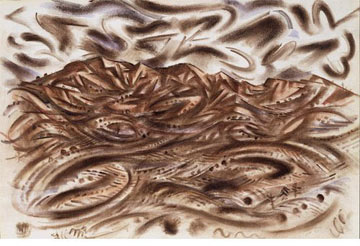'The Cubist Impulse in American Art'
at Gerald Peters Gallery, Santa Fe, New Mexico
Recommendation by Kathryn M. Davis
 Andrew Dasburg, 'Rhythmic Earth,' 1933, conte crayon and watercolor, 14 3/4 x 21 1/4'.
Andrew Dasburg, 'Rhythmic Earth,' 1933, conte crayon and watercolor, 14 3/4 x 21 1/4'.
Andrew Dasburg, 'Rhythmic Earth,' 1933, conte crayon and watercolor, 14 3/4 x 21 1/4'.
It can easily be argued that the movement known as Cubism, which emerged in Paris very early in the 20th century, was skillfully adopted in the United States as artists in New York began to investigate what distinguished their work as modern and “American.” What is not so often contended, however, is the notion that New Mexico - the very physicality of its geography and the concept of the land as inspiration - contributed substantially to that investigation. Certainly, Alfred Stieglitz and his circle at Gallery 291, including painters John Marin and Max Weber, were deeply involved with the definition and development of an American art and found the West key to their theoretical inquiry. “The Cubist Impulse in American Art” makes the case that Cubism played a significant role in early American modernism, presenting works by Marin and Weber alongside paintings by Andrew Dasburg, Stuart Davis, and other intellectuals who traveled to New Mexico to make art that would eventually transcend its original European influences. At its best (Dasburg’s “Rhythmic Earth” is a standout), the exhibition reveals the depths of New Mexico’s importance to a new art for a new century.
It can easily be argued that the movement known as Cubism, which emerged in Paris very early in the 20th century, was skillfully adopted in the United States as artists in New York began to investigate what distinguished their work as modern and “American.” What is not so often contended, however, is the notion that New Mexico - the very physicality of its geography and the concept of the land as inspiration - contributed substantially to that investigation. Certainly, Alfred Stieglitz and his circle at Gallery 291, including painters John Marin and Max Weber, were deeply involved with the definition and development of an American art and found the West key to their theoretical inquiry. “The Cubist Impulse in American Art” makes the case that Cubism played a significant role in early American modernism, presenting works by Marin and Weber alongside paintings by Andrew Dasburg, Stuart Davis, and other intellectuals who traveled to New Mexico to make art that would eventually transcend its original European influences. At its best (Dasburg’s “Rhythmic Earth” is a standout), the exhibition reveals the depths of New Mexico’s importance to a new art for a new century.

